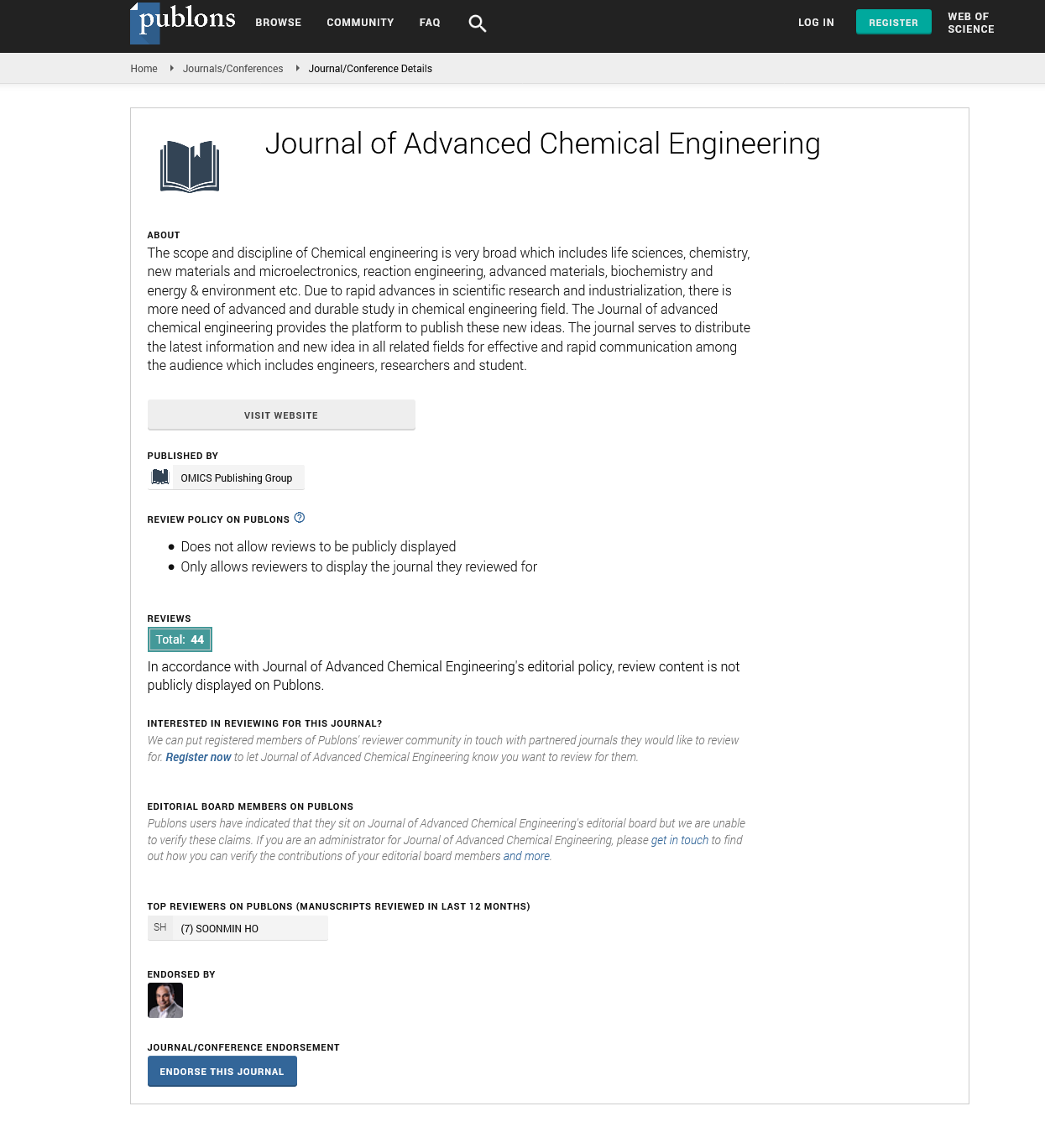Indexed In
- Open J Gate
- Genamics JournalSeek
- Smithers Rapra
- RefSeek
- Directory of Research Journal Indexing (DRJI)
- Hamdard University
- EBSCO A-Z
- OCLC- WorldCat
- Scholarsteer
- Publons
- Geneva Foundation for Medical Education and Research
- Google Scholar
Useful Links
Share This Page
Journal Flyer

Open Access Journals
- Agri and Aquaculture
- Biochemistry
- Bioinformatics & Systems Biology
- Business & Management
- Chemistry
- Clinical Sciences
- Engineering
- Food & Nutrition
- General Science
- Genetics & Molecular Biology
- Immunology & Microbiology
- Medical Sciences
- Neuroscience & Psychology
- Nursing & Health Care
- Pharmaceutical Sciences
Opinion Article - (2023) Volume 13, Issue 1
Determination of Isothermal Crystallization Techniques
Weber Conn*Received: 03-Feb-2023, Manuscript No. ACE-23-19701; Editor assigned: 06-Feb-2023, Pre QC No. ACE-23-19701 (PQ); Reviewed: 21-Feb-2023, QC No. ACE-23-19701; Revised: 28-Feb-2023, Manuscript No. ACE-23-19701 (R); Published: 07-Mar-2023, DOI: 10.35248/2090-4568.23.13.270
Description
A formula was developed to express the volume fraction, x, of crystals that precipitate in a glass when it is heated at a constant phase. In [-ln(1-x)]=-n(n-1.052mE/RT+Constant, where E is the activation energy for crystal development and n is a numerical factor based on the nucleation process, x is stated when crystal particles grow in m dimensions. When the dominating nuclei are those generated during the heating at a constant rate, n equals to m+1, and when the dominant nuclei are those formed during the preceding heat-treatment before the thermal analysis run, n equals to m. Applying this equation to a Li2O2SiO2 glass proved its accuracy and applicability. The modified Ozawa-type plot was presented as a method for estimating the values of n and m from DSC curves, and it was found to be highly helpful and convenient for measuring the activation energy for crystal development [1].
By melting organically modified layered silicates (organoclay) and biodegradable polycaprolactone, nanocomposites based on these materials were created. Differential scanning calorimetry (DSC) and rheometry were used in dynamic testing to examine the isothermal crystallization of PCL/clay nanocomposites at various clay concentrations (from 0.1 to 10 wt%). As seen by a notable decrease in the crystallization half-time, t1/2, the results demonstrated that the well-dispersed organoclay platelets served as nucleating agents in the PCL matrix [2].
When clay concentrations were relatively low, this effect was the strongest. Particularly, t1/2 was one order of magnitude less than the pure polymer in composites containing 0.4% clay. The heating thermograms on PCL and PCL/clay after isothermal crystallization revealed a decrease in melting temperature with increasing clay content, indicating that the degree of crystallinity and crystallization perfection were influenced by the chains limited mobility, which prevented the development of well- developed lamellar crystals. The rheological measurements verified clay's impact on the kinetics of crystallization. During isothermal studies, the development of the crystalline phase and the clay concentration were associated with the evolution of G' (which measures the elastic component) and G'' (which measures the plastic component) vs time [3]. By exposing samples to 32.4% relative humidity, measuring the uptake of water vapour and subsequent loss over time due to crystallization, and using differential scanning calorimetry to determine the crystallization temperature, Tc, researchers have studied the crystallization of a model compound, sucrose, from the amorphous solid state isothermally at 30°C.
The ability to forecast Tc and so directly link the plasticizing effects of water to its propensity to promote crystallization was made possible by measuring the glass transition temperature, Tg, and melting temperature, Tm, for sucrose alone and in the presence of absorbed water [4].
Even at concentrations as low as 1% w/w to 10% w/w, colyo- philization of sucrose with lactose, trehalose and raffinose, all of which had Tg values higher than those of sucrose, dramatically raised Tc. The presence of the additives at these low levels significantly increased the induction time, which in the isothermal studies is the time needed for crystallization to start due to the plasticizing effects of water and is assumed to be primarily affected by rates of nucleation, with raffinose having a greater effect than lactose and trehalose [5].
References
- Yang Z, Houk KN. The dynamics of chemical reactions: atomistic visualizations of organic reactions, and homage to van’t Hoff. Chemistry. 2018; 24(16):3916-3924.
[Crossref] [Google Scholar] [PubMed]
- Barducci A, Bonomi M, Parrinello M. Metadynamics. Wiley Interdiscip. Rev. Comput. Mol. Sci 2011;1(5):826-843.
- Melville J, Hargis C, Davenport MT, Hamilton RS, Ess DH. Machine learning analysis of dynamic‐dependent bond formation in trajectories with consecutive transition states. J Phys Org Chem 2022;35(11):e4405.
- Wang HF, Liu ZP. Comprehensive mechanism and structure-sensitivity of ethanol oxidation on platinum: new transition-state searching method for resolving the complex reaction network. J Am Chem Soc. 2008;130(33):10996-10004.
[Crossref] [Google Scholar] [PubMed]
- Dewyer AL, Argüelles AJ, Zimmerman PM. Methods for exploring reaction space in molecular systems. Wiley Interdiscip. Rev. Comput. Mol. Sci. 2018;8(2):e1354.
Citation: Conn W (2023) Determination of Isothermal Crystallization Techniques. Adv Chem Eng. 13:270.
Copyright: © 2023 Conn W. This is an open-access article distributed under the terms of the Creative Commons Attribution License, which permits unrestricted use, distribution, and reproduction in any medium, provided the original author and source are credited.

